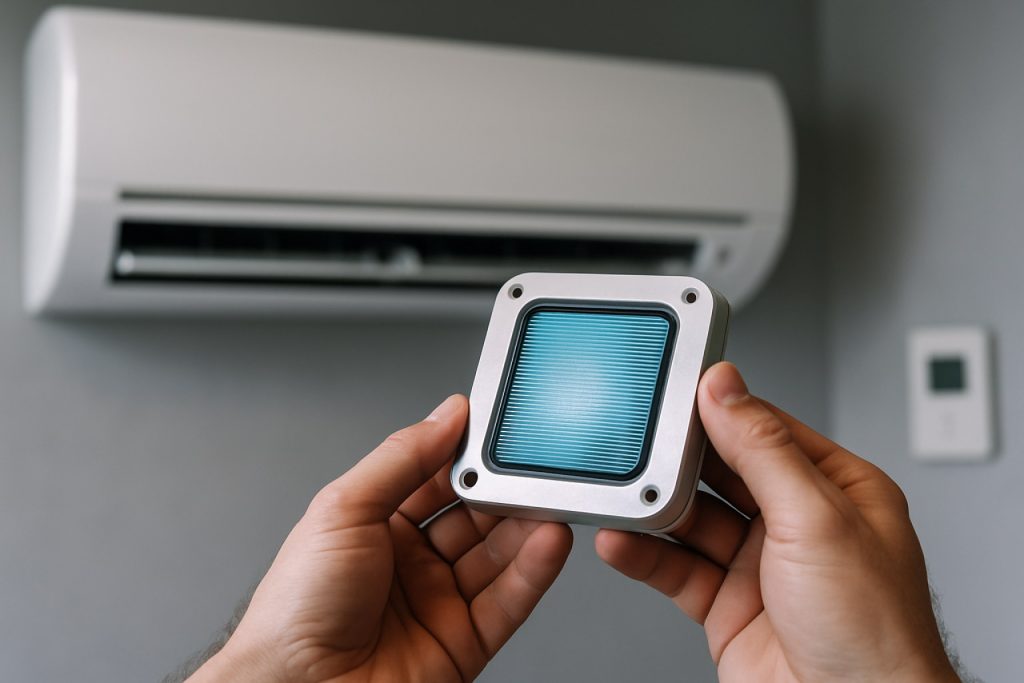
Barocaloric Cooling Materials: The Next Leap in Sustainable Temperature Control. Discover How Pressure-Driven Innovation Could Transform Air Conditioning Forever.
- Introduction: What Are Barocaloric Cooling Materials?
- How Barocaloric Cooling Works: The Science Explained
- Key Advantages Over Traditional Cooling Technologies
- Environmental Impact and Energy Efficiency
- Recent Breakthroughs and Leading Research
- Challenges and Limitations in Current Barocaloric Materials
- Potential Applications: From Refrigeration to Electronics
- Future Outlook: Commercialization and Market Potential
- Sources & References
Introduction: What Are Barocaloric Cooling Materials?
Barocaloric cooling materials are a class of solid-state substances that exhibit significant thermal changes when subjected to variations in pressure, making them promising candidates for next-generation, environmentally friendly refrigeration technologies. Unlike conventional vapor-compression systems that rely on greenhouse gases, barocaloric materials leverage the barocaloric effect—a reversible temperature and entropy change induced by applying or releasing pressure—to achieve cooling. This mechanism offers a pathway to more sustainable and efficient cooling solutions, addressing both energy consumption and environmental impact concerns associated with traditional refrigerants.
The barocaloric effect is closely related to other caloric effects, such as magnetocaloric and electrocaloric effects, but is uniquely driven by mechanical pressure rather than magnetic or electric fields. Materials that display strong barocaloric responses often undergo pressure-induced phase transitions, such as order-disorder or structural changes, which are accompanied by substantial heat absorption or release. Recent research has identified a variety of compounds—including organic-inorganic hybrids, plastic crystals, and certain metal-organic frameworks—that demonstrate large barocaloric effects near room temperature, making them particularly attractive for practical applications Nature.
The development and optimization of barocaloric materials are active areas of research, with efforts focused on enhancing their caloric strength, reducing the required pressure, and improving their mechanical stability and cycling durability. As the demand for sustainable cooling technologies grows, barocaloric materials are poised to play a pivotal role in the transition toward greener refrigeration systems Elsevier.
How Barocaloric Cooling Works: The Science Explained
Barocaloric cooling leverages the unique thermodynamic properties of certain materials that undergo significant entropy and temperature changes when subjected to pressure variations. Unlike conventional vapor-compression refrigeration, which relies on the phase change of refrigerants, barocaloric cooling exploits solid-state materials that exhibit a barocaloric effect—a reversible thermal response to applied or released pressure. When pressure is applied to a barocaloric material, its crystal lattice structure becomes more ordered, resulting in a decrease in entropy and the release of heat. Conversely, when the pressure is removed, the material absorbs heat from its surroundings as its entropy increases, thus producing a cooling effect.
The efficiency of barocaloric cooling depends on the magnitude of the entropy change (ΔS) and the adiabatic temperature change (ΔT) that the material can achieve under moderate pressures. Materials such as plastic crystals, metal-organic frameworks, and certain perovskites have demonstrated promising barocaloric effects, with some exhibiting temperature changes of several degrees Celsius under pressures of a few hundred megapascals. The process is inherently solid-state, eliminating the need for volatile or environmentally harmful refrigerants, and offers the potential for compact, efficient, and eco-friendly cooling devices.
Recent research focuses on optimizing the barocaloric properties of materials, improving their mechanical stability, and reducing the required operating pressures to make the technology viable for commercial applications. The development of barocaloric cooling materials is seen as a promising pathway toward sustainable refrigeration and air conditioning, addressing both energy efficiency and environmental concerns Nature, Elsevier.
Key Advantages Over Traditional Cooling Technologies
Barocaloric cooling materials offer several key advantages over traditional vapor-compression refrigeration technologies, positioning them as promising candidates for next-generation cooling systems. One of the most significant benefits is their potential for high energy efficiency. Unlike conventional systems that rely on the compression and expansion of environmentally harmful hydrofluorocarbon (HFC) refrigerants, barocaloric materials utilize solid-state phase transitions induced by pressure changes, which can result in lower energy consumption and reduced operational costs U.S. Department of Energy.
Another major advantage is the environmental impact. Barocaloric materials eliminate the need for volatile and greenhouse gas-emitting refrigerants, directly addressing concerns about global warming and ozone depletion associated with traditional cooling methods U.S. Environmental Protection Agency. This makes barocaloric cooling a more sustainable and eco-friendly alternative.
Additionally, barocaloric systems can be more compact and mechanically simpler, as they do not require compressors or complex fluid circuits. This can lead to quieter operation, lower maintenance requirements, and greater design flexibility for integration into various applications, from household appliances to industrial cooling Nature.
Finally, the rapid and reversible nature of the barocaloric effect allows for fast thermal cycling, which is advantageous for applications requiring precise temperature control. Collectively, these advantages highlight the transformative potential of barocaloric cooling materials in addressing the limitations of traditional refrigeration technologies.
Environmental Impact and Energy Efficiency
Barocaloric cooling materials have emerged as a promising alternative to conventional vapor-compression refrigeration systems, primarily due to their potential for reduced environmental impact and enhanced energy efficiency. Traditional cooling technologies often rely on hydrofluorocarbon (HFC) refrigerants, which are potent greenhouse gases with high global warming potential. In contrast, barocaloric materials operate through solid-state phase transitions induced by pressure changes, eliminating the need for harmful refrigerants and thereby significantly reducing direct emissions of greenhouse gases United Nations Environment Programme.
From an energy efficiency perspective, barocaloric materials can achieve substantial entropy changes under moderate pressure variations, enabling efficient heat exchange with lower mechanical work compared to gas compression cycles. This can translate into lower operational energy consumption and reduced carbon footprint over the system’s lifetime Nature. Furthermore, the absence of volatile fluids minimizes leakage risks and maintenance requirements, contributing to the overall sustainability of barocaloric cooling systems.
However, the environmental benefits of barocaloric materials depend on the choice of the material itself. Some barocaloric compounds may contain elements or require synthesis processes with their own environmental concerns, such as toxicity or resource scarcity. Ongoing research is focused on developing barocaloric materials that are not only efficient and durable but also composed of abundant, non-toxic elements Materials Today. As these challenges are addressed, barocaloric cooling technologies hold significant promise for greener, more energy-efficient refrigeration and air conditioning solutions.
Recent Breakthroughs and Leading Research
Recent years have witnessed significant breakthroughs in the development and understanding of barocaloric cooling materials, positioning them as promising candidates for next-generation solid-state refrigeration. Notably, research has focused on optimizing the barocaloric effect—whereby materials exhibit large, reversible thermal changes under applied pressure—by exploring new material classes and engineering their microstructures. A landmark achievement was the discovery of colossal barocaloric effects in plastic crystals such as neopentylglycol (NPG), which demonstrated entropy changes comparable to or exceeding those of conventional refrigerants, but without the associated environmental hazards Nature.
Further advances have been made in hybrid organic-inorganic perovskites and metal-organic frameworks (MOFs), which offer tunable barocaloric properties and improved mechanical stability. Researchers at the University of Cambridge and Spanish National Research Council (CSIC) have reported barocaloric materials that operate near room temperature and under moderate pressures, making them more viable for practical applications. Additionally, the integration of computational materials science and high-throughput screening has accelerated the identification of new candidates with enhanced performance and reduced hysteresis losses Nature Reviews Materials.
Collaborative international projects, such as the BAROCOR Project (European Commission), are driving the transition from laboratory-scale demonstrations to prototype devices. These efforts are addressing key challenges, including material fatigue, scalability, and device integration, thereby paving the way for environmentally friendly, efficient cooling technologies based on barocaloric materials.
Challenges and Limitations in Current Barocaloric Materials
Despite the promising potential of barocaloric cooling materials for environmentally friendly refrigeration, several challenges and limitations hinder their widespread adoption. One of the primary issues is the requirement for high pressures—often in the range of hundreds of megapascals—to induce significant barocaloric effects. Such high pressures complicate device engineering, increase operational costs, and raise safety concerns, making practical implementation difficult for consumer applications (Nature).
Another significant limitation is the relatively low barocaloric effect observed in many candidate materials at room temperature. While some materials, such as certain organic-inorganic hybrid perovskites and plastic crystals, exhibit large entropy changes, their mechanical stability and long-term durability under repeated pressure cycling remain questionable (Elsevier). Fatigue, phase segregation, and irreversible structural changes can degrade performance over time, limiting the lifespan of barocaloric devices.
Additionally, many barocaloric materials contain toxic or rare elements, such as lead or expensive transition metals, which pose environmental and economic concerns. The search for abundant, non-toxic, and recyclable alternatives is ongoing but has yet to yield materials with both strong barocaloric effects and practical viability (Cell Press).
Finally, the integration of barocaloric materials into efficient, compact, and scalable cooling systems remains a significant engineering challenge. Issues such as heat transfer efficiency, pressure application mechanisms, and system miniaturization must be addressed before barocaloric cooling can compete with conventional refrigeration technologies (MDPI).
Potential Applications: From Refrigeration to Electronics
Barocaloric cooling materials, which exhibit significant thermal changes under applied pressure, are emerging as promising candidates for a range of energy-efficient cooling applications. Their potential extends well beyond traditional refrigeration, offering innovative solutions in sectors where conventional vapor-compression systems are limited by size, environmental impact, or efficiency constraints.
In domestic and commercial refrigeration, barocaloric materials could replace or supplement existing technologies, reducing reliance on hydrofluorocarbon refrigerants that contribute to global warming. Their solid-state nature allows for compact, leak-free designs, making them attractive for next-generation refrigerators and freezers. Additionally, barocaloric cooling can be precisely controlled, enabling rapid temperature modulation and improved energy efficiency in food preservation and air conditioning systems International Energy Agency.
Beyond large-scale cooling, barocaloric materials are particularly suited for thermal management in electronics. As device miniaturization continues, efficient heat dissipation becomes critical to prevent overheating and ensure reliability. Barocaloric cooling elements can be integrated directly onto chips or within electronic enclosures, providing localized, on-demand cooling without moving parts or bulky heat sinks Nature Reviews Materials. This opens avenues for their use in high-performance computing, telecommunications, and wearable devices.
Furthermore, the tunability of barocaloric effects through material engineering enables customization for specific temperature ranges and operational pressures, broadening their applicability to automotive climate control, medical devices, and even space technology. As research advances, the versatility and environmental benefits of barocaloric cooling materials are expected to drive their adoption across diverse industries European Commission.
Future Outlook: Commercialization and Market Potential
The future outlook for barocaloric cooling materials is promising, with significant potential for commercialization and market growth as the demand for sustainable and energy-efficient cooling technologies intensifies. Barocaloric materials, which exploit pressure-driven phase transitions to achieve cooling, offer a compelling alternative to conventional vapor-compression refrigeration systems that rely on environmentally harmful hydrofluorocarbons (HFCs). The global push for decarbonization and stricter regulations on greenhouse gas emissions are accelerating research and development in this field, positioning barocaloric cooling as a viable solution for next-generation refrigeration and air conditioning applications.
Key challenges remain before widespread commercialization can be realized. These include the need for scalable synthesis of barocaloric materials with large entropy changes at near-ambient pressures, mechanical robustness under repeated cycling, and integration into practical device architectures. Recent advances in organic-inorganic hybrid materials and elastomers have demonstrated improved barocaloric effects and durability, bringing the technology closer to market readiness Nature. Furthermore, the development of compact, cost-effective pressure-application systems is critical for the adoption of barocaloric cooling in consumer and industrial markets.
Market potential is substantial, particularly in regions with high cooling demand and strong regulatory incentives for low-global-warming-potential technologies. Early adoption is likely in niche applications such as electronics cooling and portable refrigeration, with broader penetration expected as material performance and system integration improve European Commission. Strategic partnerships between material scientists, device engineers, and industry stakeholders will be essential to accelerate commercialization and unlock the full market potential of barocaloric cooling materials.
Sources & References
- Nature
- United Nations Environment Programme
- University of Cambridge
- Spanish National Research Council (CSIC)
- BAROCOR Project (European Commission)
- International Energy Agency



